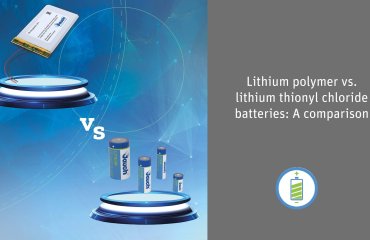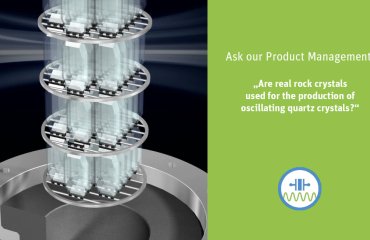
What do the first Samsung cellphone, your smoke detector and the control unit of your car’s center console have in common? In each of them, a clock cycle is generated by a frequency control product. A part that is often missed and easy to overlook, since they are small and do not attract much attention. A frequency control product often hardly covers the head of a needle— our smallest quartz crystal measures between just 1.6 and 1.2 millimeters! Would you have known which component in this electronic circuit is the oscillator?
Only a specialist can distinguish between the various components. Furthermore, we do not usually get to see the individual components of a TV control unit circuit in such detail. Despite all of this, however, it is high time today that quartz crystals and oscillators be given the recognition that they have deserved for so long.
To give credit where credit is due, these two elements are present day in and day out, providing, without fuss, the all-important clock signal required for many applications. Just imagine what might happen if a clever inventor forgot to include the frequency control product or if the quartz crystal suddenly stopped functioning? This is almost inconceivable: it would be a drama, the circuit would require an emergency operation and to be taken to intensive care. This is a situation that can be compared with a severe disruption to the human heart, which generates our own ‘clock signal’.
By now you must realize how fundamental our frequency components are. And were the circuit to be brought to intensive care, we in our company would be at the center of the action, which would involve, specifically, our experienced technical support engineers, who would use their trained eye and ample experience in our lab to carry out the operation successfully.
But let’s go back and start at the very beginning. What is quartz anyway, and what has been the success story of this valuable mineral in Villingen-Schwenningen so far?
Quartz: the second-most common mineral on Earth
Quartz is a mineral with the basic chemical structure of silicon dioxide, and in this condition it is the second most common mineral in the Earth’s crust. Did you know that quartz is so hard that it can be used to cut glass? On the hardness scale of 1 to 10 created by Friedrich Mohs, quartz has a value of 7—”very hard”. By comparison, a diamond has a Mohs hardness of 10 and so represents the top end of the hardness scale.
Quartz is one of the most important minerals for industry and is an important raw material for the glass, cement and ceramics industries. Quartz gravel and broken quartz is used as an abrasive in cleaning agents or as sand for spreading on roads. In addition quartz has been used as a gemstone for time immemorial. Amethyst, rock crystal, smoky quartz, and ametrine are popular gemstones and energy stones.
Electricity applied to quartz – resulting in a highly dependable clock generator
Finally, quartz crystals are needed to cut out the smallest slices, the blanks, which are then packaged in a casing, which is placed in electronic circuits or in quartz watches as a clock. This is because quartz mineral has a very special property. When an electric voltage is applied to quartz, it deforms slightly. As soon as the voltage is removed, the quartz returns to its original form. If now we apply an alternating voltage at a specific frequency to the quartz, the quartz will begin to oscillate strongly. This resonant frequency is very constant and is determined by the geometry of the quartz slice. Thanks to this property, quartz creates a very precise clock. And that’s exactly why quartz sets the pace, especially for quartz watches.
So what does quartz have to do with Jauch?
To understand this, let’s take a short journey back through our history to the 1950s, where we find Herbert Christian Jauch, a resourceful entrepreneur from Schwenningen. In the 1950s, clocks from the Black Forest were in demand all over the world. In 1954 Herbert Christian Jauch, the father of the current company owner and director Thomas Jauch, set up the company as a supplier to the Black Forest clock industry. As a trading company, Jauch was involved in selling the precision parts of mechanical watches such as the spindles, shafts, and gear wheels needed by clock makers. By the 1970s, however, the microelectronics of quartz clocks were taking over the market from mechanical clocks. Herbert C. Jauch spotted the potential of this technical change and in 1974 took on representation for Motorola. In doing so he provided access for the clock industry of southwestern Germany to the now much sought-after clock quartzes. So this is the point at which we encounter quartz in Villingen-Schwenningen for the first time; this extraordinary material will go on to have a decisive impact on the history of the company.
An extended product portfolio: clock generators for many industrial applications
By the 1970s, a reliable clock signal was not just needed for clocks themselves. The arrival of electronics in other areas of industry enabled the portfolio to be expanded quickly. After all, technical progress could no longer be held back by electronics, which was also to the benefit of Jauch. The company became a major supplier for consumer electronics throughout Germany, supplying companies such as Saba in the Black Forest, as well as Grundig. As a result, Jauch became known worldwide for its exports of frequency-generating components from Villingen-Schwenningen.
Jauch’s frequency control products were required at this time in telecommunications, consumer electronics, and appliances, and were incorporated in the first PCs and gaming consoles, as well as the first Siemens cellphone. Our experience with these products and our cooperation with their manufacturers laid the foundation for the development of the company into an international producer and partner in the electronics industry.
By now, Jauch was offering not only quartz crystals but also quartz oscillators to meet the technical requirements of the various industries. A quartz oscillator is a piece of quartz combined with an electrical circuit that sets the quartz in oscillation. Both elements are contained in a single housing. The oscillator needs only a steady operating voltage in order to actively supply the downstream circuitry with a high-precision clock signal.
Jauch captures Asia
While up until then Jauch had supplied all its industries from Europe, there was now a strong inclination in the company from Villingen-Schwenningen to make overtures to Asia. The company entered into cooperation with manufacturers in Japan and Taiwan to produce quartz crystals and oscillators, and eventually a subsidiary was set up in Hong Kong. The demand in the electronics industry was soon for more complex frequency-generating components. In 1986 Jauch presented the first oscillator in a dual in-line (DIL) housing. Through its cooperation with JVC in Japan, Jauch gained access to oscillator technology and began to supply quartz oscillators, for example, to the long-established Triumph-Adler brand for electronic typewriters.
In 1987 Thomas Jauch took over the directorship and continued to pursue business relationships in the Asian region. Like his father, Herbert C. Jauch, Thomas Jauch is a visionary who is ahead of his time, and who invested at an early stage in decisive Asian partnerships. These are links that have led to long-standing friendships today.
But let’s go back to the exciting history of our frequency components. In 1988 the first factory for production of the HC49/U was created in Putian, China. In the same year Jauch was already offering its customers the first quartz oscillator in a SMD version. SMD stands for ‘surface-mounted device’. The flat contact pads of the oscillator are soldered directly to the surface of the PCB; unlike with wire-connected oscillators, SMD parts do not require wire leads.
The pioneering spirit with which Jauch acted in Asia was paying off. In the years that followed, facilities were set up in quick succession for standard quartz in large-scale series production and many areas of cooperation were set up that still operate today. Meanwhile, developments were continuing in Europe: a first quartz production site was built at the company’s headquarters in Villingen-Schwenningen.
The “Made in Germany” quality standard
Creating the conditions in which the high quality standards met by the German-made frequency components are also reliably met in the production series in the Far East was at once the challenge facing the company, and has ultimately been the secret of its success. The “Made in Germany” quality standard was brought to bear on the Asian production facilities. Production in Indonesia began in 1993 with P. T. Great. In 2000 Jauch took over the production facilities of the long-standing Japanese partner Meiden in Singapore and Malaysia for high-end production of low-profile SMD quartz crystals, such as the MG3A, SMU2, and SMU3 versions. A few years later production was moved to Indonesia.
Quality provides security: from the Black Forest to the world
Today, development and production of prototypes, high-quality small batches, and samples to customer specifications takes place at our headquarters in Villingen-Schwenningen. In 2015, Jauch in Germany invested in a programming center for MEMS oscillators. Here, MEMS oscillators are configured to customer specifications. MEMS stands for ‘micro electro-mechanical system’ – a miniature electromechanical unit that is often smaller than a millimeter in size and that can process mechanical and electrical information. One such specialized electromechanical system is the MEMS oscillator.
In China, standard quartz elements continue to be produced for both medium and large series. Through these means, Jauch can continue to guarantee the ‘Made in Germany’ quality standard throughout the entire value chain. The extensive production knowledge of the company can also be seen in its quality assurance. Audits of suppliers and partners in Asia are carried out regularly by trained Jauch employees with extensive experience. And it goes without saying that only the highest-quality quartz blanks with accurately measured cutting angles are used. For Jauch the selection of raw materials, the high-quality quartz, is also in the hands of highly-trained personnel, who have learnt their trade from the bottom up. All these measures ensure the consistently high quality of our frequency components and give Jauch’s customers around the world reassurance as to the reliability of their clock generators.
It is good to be quartz at Jauch
Partners as dependable as our reliable quartz crystals and oscillators have earned equally dependable technical support from Jauch. Now we have come back to the start of our quartz journey. Do you remember our colleagues from technical support? It is our technicians and engineers who nurture our frequency components day by day. Here is a good place to be quartz!
Are you at the stage of deciding on a frequency-generating component from Jauch? Jauch’s experts know which clock generator is the best solution for each application. Already begun the design phase? If you bring our technical experts on board, they can respond with customer-specific recommendations for the appropriate circuit. The product is already created and in use by many end users, but now there are problems with generating the clock signal? Our technical support department is ready to examine the circuit in the closest detail in our in-house laboratory. Because, as we mentioned earlier, the frequency-generating component of a product is analogous in importance to a human heart. Economizing on quality and technical knowledge at this point is not an option. For this reason, our customers and friends all over the world have put their confidence in components from Jauch for over 60 years. They can see how much our quartz, our oscillators, and our customers have grown dear to us.
Come with us on our exciting journey. There is still so much more to discover! We look forward to meeting you.


 Deutsch
Deutsch 

